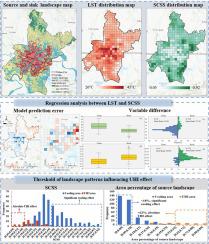Landscape and Urban Planning ( IF 7.9 ) Pub Date : 2021-10-07 , DOI: 10.1016/j.landurbplan.2021.104260 Jing Gao 1 , Jian Gong 1, 2 , Jianxin Yang 1, 2 , Jingye Li 1, 3 , Shicheng Li 1, 2

|
Studies on the interactions between landscape patterns and land surface temperature (LST) are critical to mitigate urban heat islands (UHIs). However, integrated spatial indices combining both composition and configuration to quantify this relationship requires further development. We present an index of spatial connectivity between patches of the heat source and sink (SCSS) to assess the heterogeneity impact of landscape patterns on LST in Wuhan, China. We examined the relationship between LST and SCSS at the urban (within the urban growth boundaries, UGBs) and city levels, using spatial regression analyses. Results show that: (1) the SCSS and LST presented a significant negative correlation, and the SCSS can explain 76% and 81% of the variability in LST at city level and urban level, respectively; (2) for every 0.1 increase in SCSS, the LST will decrease by 0.96 °C at city level, and 1.67 °C at urban level; (3) the percentage of the source landscape area should be no more than 62% and the SCSS should not fall below 0.18 to control the UHI effect; (4) maintaining the percentage of the source landscape area at below 18%, and the value of SCSS at over 0.43, will help to bring about a significant cooling effect. Our findings allow a better understanding of the interactions between the spatial heterogeneity and the thermal regulation function of landscapes and provide insights for urban planners to mitigate the UHI effect.











































 京公网安备 11010802027423号
京公网安备 11010802027423号